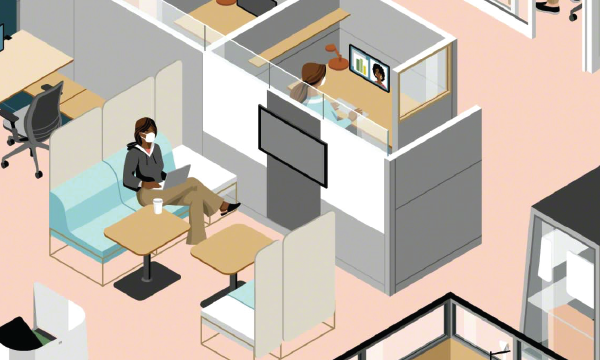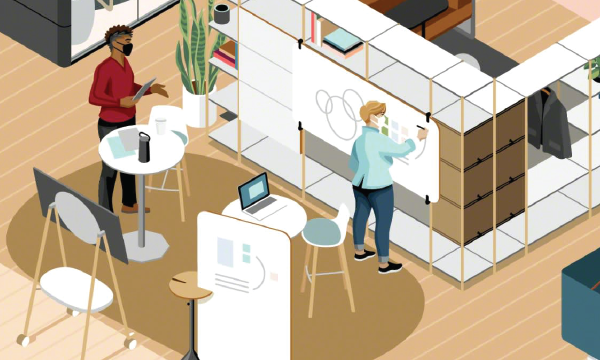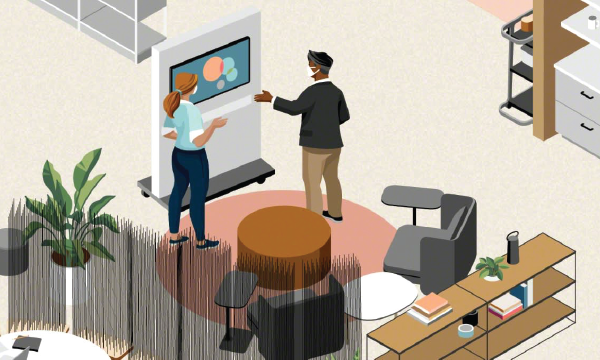We use cookies to make this site as useful as possible and maximize your experience. By closing this message, you consent to our cookies on this device in accordance with our cookie policy unless you have disabled them in your browser settings.
Office of the Future: 4 Workplace Shifts For Organizations, Part 3

Our individual experiences during the pandemic brought on new expectations that organizations must now consider as their employees return to the office. Expectations were already changing pre-COVID-19, but the crisis accelerated the need to create better workplaces. bkm has identified four macro shifts leaders will need to embrace to create safe and compelling places that reflect the new office of the future.
Design for Safety
Research shows that among the most pressing concerns about returning to work, safety is number one. Employees will want to know their employer is doing everything possible to keep them safe. To be inclusive, organizations will need a holistic safety strategy that considers everyone’s safety, regardless of age, abilities or health issues.
Pre-pandemic, when organizations addressed safety in the workplace, their focus was primarily on occupational health and safety standards. Now, they will need to take a multifaceted approach that prioritizes reducing the spread of disease. This will require protocols such as mask wearing and social distancing. It will also require organizations to understand how airborne viruses move through an office environment. Even though vaccines are now widely available, addressing these new safety elements will better help organizations prepare for any future crises.
New safety elements organizations should consider:
- Air quality
- Flexible, breathable floor plans
- Desk placement and office space design
- Division and levels of social distancing
- Cleanable and safe work materials
- Sanitation
- Cleaning frequency
- Hands-free devices
- Control over physical boundaries to feel safe
Design for Productivity
Pre-pandemic, many organizations focused primarily on efficiency when designing their office spaces. Many were made for single-purpose use. In addition, some open-plan offices were heavily criticized for not supporting people’s need for focus. Moving forward, organizations will benefit from creating multi-use spaces that support collaboration and focus work equally.
The office space of the future can’t simply be a social hub that brings people together with the expectation that individual work will happen at home. Research tells us this is not an inclusive strategy since many people struggle to focus while telecommuting. The solution is to provide places where people can work together, as well as places where they can do individual, focused work.

To meet the needs of all types of work, the workplace will need to support things such as:
- In-person collaboration
- Virtual collaboration
- Privacy
- Physical movement
Design to Inspire Community
For many years, aesthetically pleasing workplaces have done well to attract and retain talent.
Moving forward, however, the workplace will also need to improve at inspiring people and building a strong community. Office spaces of the future will have to provide the touches of humanity and warmth people are seeking to counter new safety precautions that have been put in place. Working from home has been an isolating experience for many people, and the need for community has never been more critical.
According to the research, people say the top two reasons they want to return to the office is to see work friends and interact with teammates. Video meetings and Zoom calls have proven not enough to overcome the sting of loneliness. They also want the familiarity of the workplace to help them feel a sense of belonging.

Moving forward, work spaces should be designed to support:
- Vitality and a positive atmosphere
- Diversity and inclusivity
- Trust and communication amongst employees and leaders
- Adaptability and resilience
- Environmental and social impact
Design for Flexibility
The pre-pandemic office space was based on traditional paradigms with spaces that were mostly designed for permanence. But this approach is problematic and leaves little room for adaptability when conditions change. As more flexible work policies are implemented, organizations will need to design spaces that reflect these new norms. Individuals and teams are seeking greater control over their environments so they can change it on demand.

To allow for greater flexibility, the workplace will need to be:
- Designed for multi-use
- Transformative and multimodal
- Movable
Designing a Better Work Experience
As we consider what people need and how the work experience is shifting, old planning paradigms will need to change. Before the pandemic, designers were asked to create spaces that attracted the best talent, supported greater collaboration, and maximized efficiency. But the office of the future will call for an even more diverse set of needs.
For more advice on how to navigate these new office space changes, check out our additional Post-COVID resources, including guidance on beginning a post-COVID design consultation. Our white-glove corporate relocation services can assist with getting your office up and running again.
Any other questions? Contact us today at (858) 569-4700 or complete this contact form to receive a FREE risk assessment and floor plan analysis.
